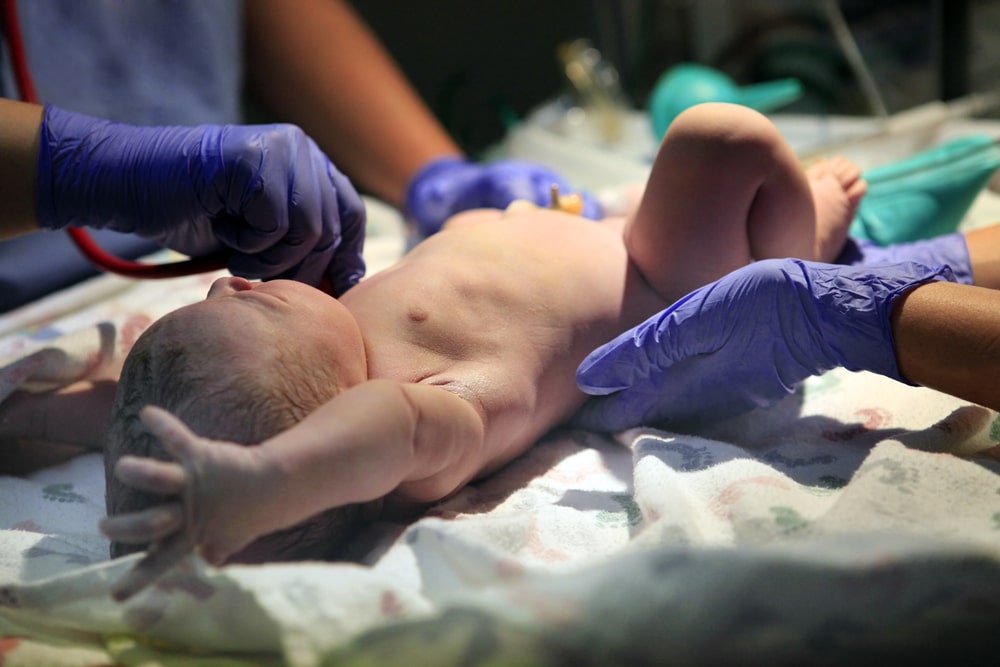
Protecting Your Rights After A Birth Injury
If you or your child was hurt in the delivery room, our Essex, MD birth injury lawyer can help you get the closure and compensation you deserve. While no amount of money can make up for the pain you’ve experienced, our team at Parker, Pallet, Slezak & Russell, LLC can help you find a way forward. We have over 45 years of experience, and with a former judge, a former prosecutor, a former police officer, and three former insurance defense attorneys onboard, our team can provide the varied approach you need to make your case a success.
Before you reach out to us for a free consultation, it’s important to learn a little more about what your birth injury case may entail — What’s an example of a birth injury? What can a lawyer do to help? And what can you expect from your case? Let’s take a look at what comes next.
What Are Some Examples Of Birth Injuries?
Birth injuries are physical injuries that occur to an infant during the process of labor and delivery. These injuries can result from various factors, such as complications during childbirth, medical negligence, or the use of forceful or improper techniques during delivery. Birth injuries can range from minor bruising to severe conditions such as cerebral palsy or brachial plexus injuries.
Birth injuries can affect mothers and babies alike. These injuries are often caused by a lack of resources, training, experience, or all of the above. It can be frustrating to discover that the people you trusted with your child’s health (and your own health) were dangerously unprepared. But with the help of our Essex birth injury lawyers, you can take some steps to build a better future.
How Can An Injury Attorney Help Me?
Every birth injury case is different. And so is every lawyer. At Parker, Pallet, Slezak & Russell, LLC, we go the extra mile to make sure your voice is heard. The right lawyer can closely investigate your case to determine whether your medical care providers were negligent or otherwise poorly equipped for the job. We can also help you sort through the paperwork when it comes to insurance battles, and help you file a lawsuit should you choose to do so.
Birth injury cases are complicated. Not only will you have to provide proof of injury, but you’ll also have to dig up medical records and even testimony from outside sources who can shed light on whatever improper practice led to your injuries in the first place. Your birth injury lawyer can walk you through the process, and help you get the information you need.
What Are My Next Steps?
If you’re wondering what you can expect from your birth injury lawsuit, you’ve come to the right place. At Parker, Pallet, Slezak & Russell, LLC, our team of attorneys is standing by to walk you through the rest of the process. From your free consultation to our investigation – and all the way to filing your claim and collecting your settlement – we’ll be with you every step of the way.
The birth of a child should be a wonderful moment. But if you or a loved one has experienced an injury in the delivery room, it’s up to your lawyers to help you get the closure you deserve. Reach out to Parker, Pallet, Slezak & Russell, LLC, today, and let’s get started on your case.
Common Avoidable Birth Injuries
If your child suffered birth injuries during labor or delivery, our experienced Essex birth injury attorneys can help you get the financial justice you deserve. Birth injuries are physical damages that occur during the process of labor and delivery. While many births proceed without complications, certain factors can lead to injuries that affect the newborn’s health. The following are four of the most prevalent birth injuries. For more details and to find out how we can help, call Parker, Pallet, Slezak & Russell, LLC.
Brachial Plexus Injury
Brachial plexus injury occurs when the network of nerves controlling the arm and hand is damaged during childbirth. This type of injury can result from excessive pulling on the baby’s head during delivery, shoulder dystocia (when the baby’s shoulder becomes stuck during delivery), or abnormal presentation of the baby.
Symptoms of brachial plexus injury may include weakness or paralysis in the affected arm, loss of muscle control, and an abnormal arm position. The baby may not move the affected arm or hand as freely as the other.
Treatment depends on the severity of the injury. Mild cases may improve with physical therapy and time, while severe cases might require surgical intervention to repair damaged nerves. Early intervention is crucial for optimizing recovery and improving outcomes.
Cephalohematoma
Cephalohematoma is a condition where blood accumulates between the baby’s skull and the periosteum (the membrane covering the bone) due to the rupture of blood vessels during birth. It commonly occurs in forceps deliveries or vacuum-assisted deliveries, where significant pressure is applied to the baby’s head.
The primary symptom of cephalohematoma is a soft, swelling area on the baby’s head, which may appear as a bump or bulge. The swelling is usually localized and does not cross suture lines (the lines where skull bones meet).
Cephalohematomas typically resolve on their own as the body gradually reabsorbs the blood. In most cases, no specific treatment is required. However, it is important to monitor the baby’s condition and ensure there are no signs of infection or further complications. In rare cases where the hematoma leads to anemia or jaundice, additional medical intervention may be necessary.
Fractures
Fractures during birth, particularly of the clavicle (collarbone) or other bones, can occur due to excessive force during delivery or abnormal presentation. Fractures are often associated with difficult deliveries, such as those involving shoulder dystocia or the use of forceps.
Symptoms of a birth fracture may include noticeable deformity, swelling, or bruising in the affected area. The baby may also exhibit limited movement or reluctance to use the affected limb.
Treatment for fractures generally involves immobilizing the affected area and supportive care. In cases of clavicle fractures, a simple arm brace or sling may be used to support the arm while it heals. With appropriate care, most fractures heal within a few weeks. Pain management and monitoring for any complications are also important aspects of treatment.
Caput Succedaneum
Caput succedaneum refers to the swelling of the soft tissues of the baby’s head due to prolonged or difficult labor. This condition occurs when the baby’s head is compressed during delivery, particularly if there is significant pressure from the birth canal or the use of delivery instruments.
The swelling associated with caput succedaneum is often soft and diffuse, covering a larger area of the baby’s head and may cross the suture lines. The swelling may be accompanied by a noticeable bulging or puffiness.
Caput succedaneum typically resolves on its own without the need for specific medical treatment. The swelling gradually decreases as the body absorbs the fluid. Monitoring the baby for any signs of complications, such as jaundice or signs of infection, is essential. In most cases, no long-term effects are associated with caput succedaneum.
Call Our Personal Injury Law Firm Today
To learn more about your legal options for your child’s birth injury, call Parker, Pallet, Slezak & Russell, LLC to schedule a free and confidential consultation with our dedicated personal injury attorneys and find out what legal recourse you may have.
Damages Available In A Birth Injury Lawsuit
Our Essex medical malpractice lawyer knows that birth injuries can have profound and long-lasting effects on both the child and their family, often necessitating extensive medical treatment, specialized care, and adjustments to daily life. When these injuries result from medical negligence, families may pursue a birth injury lawsuit to seek compensation for the damages they have incurred. In such cases, several types of damages may be available to address the various impacts of the injury. Here are the four most common types of damages that the legal team from Parker, Pallet, Slezak & Russell, LLC can pursue on your behalf.
Medical Expenses
Medical expenses are typically the most significant and immediate concern in birth injury cases. These damages cover the cost of past, present, and future medical care required due to the injury. This can include hospital stays, surgeries, medications, physical therapy, occupational therapy, and specialized equipment such as wheelchairs or communication devices.
For example, a child with cerebral palsy resulting from a birth injury may require lifelong physical therapy, multiple surgeries, and assistive devices to manage their condition. The costs associated with these treatments can be astronomical, and a successful lawsuit can help ensure that these expenses do not financially burden the family.
Pain And Suffering
Pain and suffering damages are awarded to compensate the child and their family for the physical pain, emotional distress, and diminished quality of life caused by the birth injury. These damages are often difficult to quantify, as they involve subjective experiences rather than specific financial costs. However, they are a crucial component of many birth injury lawsuits.
The child’s long-term suffering, including physical discomfort, emotional trauma from living with a disability, and the psychological impact on the family, are all considered when determining these damages. In cases where the child is unable to experience a normal childhood due to their injuries, the compensation for pain and suffering can be substantial.
Lost Earning Capacity
Lost earning capacity refers to the future income the child may never earn due to the limitations imposed by their injury. If a birth injury results in a permanent disability that affects the child’s ability to work or pursue a career, the family may be awarded damages to compensate for this lost potential.
For instance, if a child’s injury prevents them from ever working or limits the type of work they can do, the family may receive compensation based on the estimated earnings the child would have likely achieved over their lifetime. This calculation typically involves expert testimony to assess the child’s future earning potential based on their health, education, and career prospects if the injury had not occurred.
Non-Economic Damages
Non-economic damages cover a range of intangible losses that are not directly tied to financial costs but nonetheless significantly impact the family. These categories can include loss of enjoyment of life, emotional distress, and loss of consortium (which refers to the loss of the benefits of a family relationship).
For parents, non-economic damages may also include compensation for the stress, anxiety, and emotional trauma they experience as a result of their child’s injury. The parents’ diminished ability to enjoy their relationship with their child due to the injury or the strain placed on the family unit as a whole are factors considered in these awards. Your Essex injury lawyer can determine what non-economic damages your family may be entitled to.
Call Our Office For Legal Help
Birth injury lawsuits can result in substantial damages to help families cope with the profound effects of medical negligence. Each type of damage serves a specific purpose in addressing the different ways a birth injury can impact a child’s life and their family’s well-being. Pursuing a lawsuit helps families obtain the financial support they need and holds the responsible parties accountable for their actions, potentially preventing future negligence. To learn more, contact Parker, Pallet, Slezak & Russell, LLC to speak with our skilled Maryland injury attorneys to see what legal options you may have for financial justice for your child’s injuries.
Essex Birth Injury Infographic
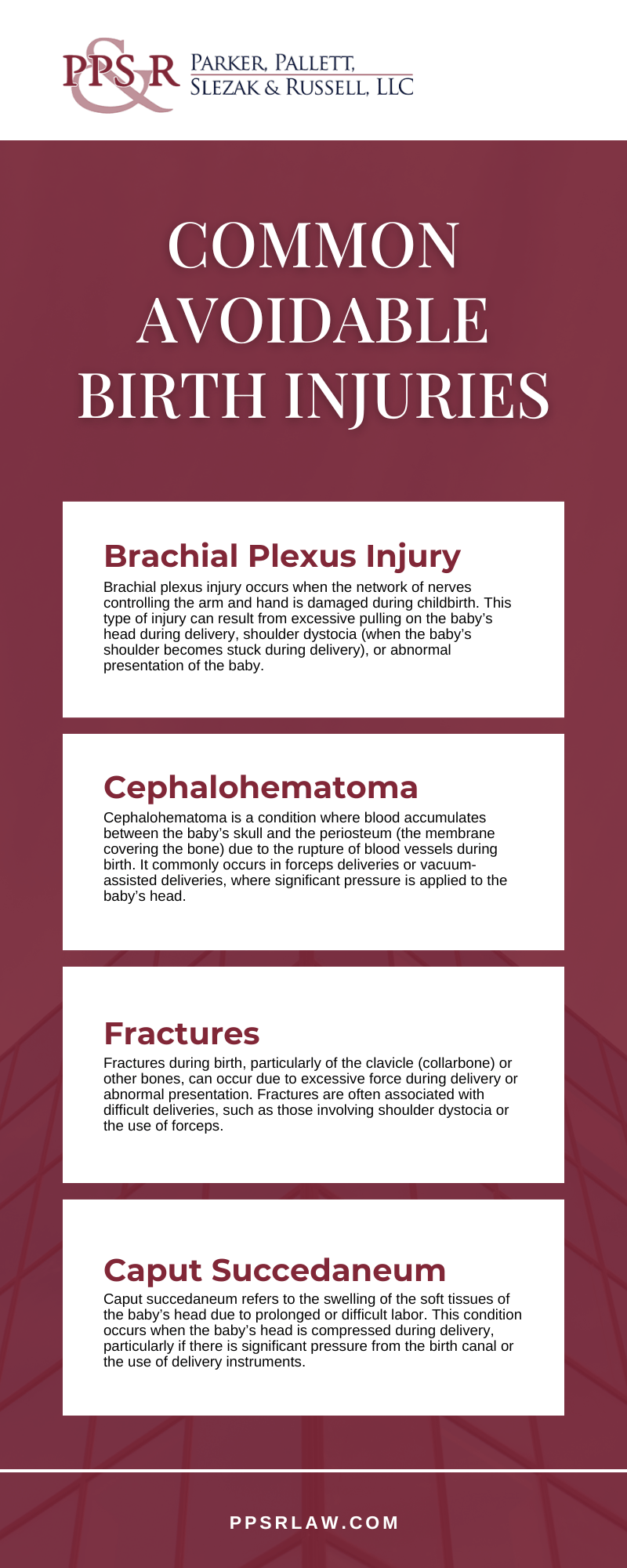
Essex Birth Injury Statistics
According to data from the Centers for Disease Control and Prevention (CDC) and other medical organizations, birth injuries remain a significant concern for both families and healthcare providers.
Key Statistics
- Prevalence Of Birth Injuries: It is estimated that about 6-8 per 1,000 live births result in some form of birth injury in the United States. The exact number can vary depending on the severity of the injury and the specific circumstances surrounding the birth.
- Common Types Of Birth Injuries: The most common types of birth injuries include brachial plexus injuries, cerebral palsy, fractures (especially clavicle fractures), and intracranial hemorrhages. Brachial plexus injuries are one of the most common and can occur due to excessive pulling during delivery or shoulder dystocia, affecting approximately 2-3 out of every 1,000 live births.
- Causes Of Birth Injuries: The primary causes of birth injuries include difficult labor, excessive force during delivery, and improper use of delivery instruments such as forceps or vacuum extractors. Certain risk factors, such as large birth weight (macrosomia) or abnormal presentation (such as breech), also increase the likelihood of birth injuries.
- Long-Term Impact: Birth injuries can lead to long-term disabilities, with 1 in 1,000 babies being born with cerebral palsy, a common consequence of birth-related trauma.
The following charts illustrate key trends:
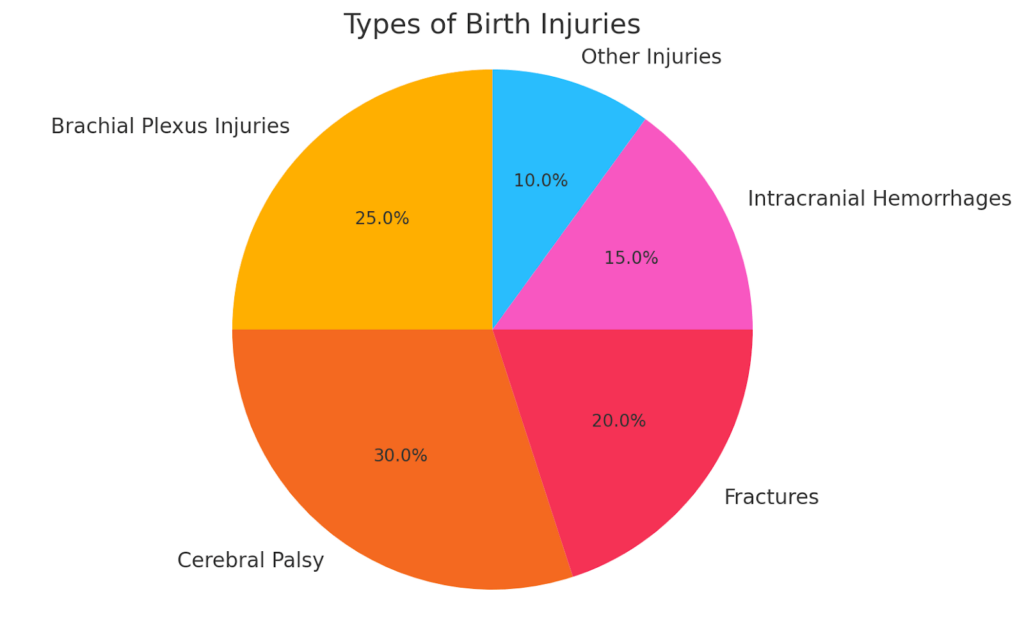
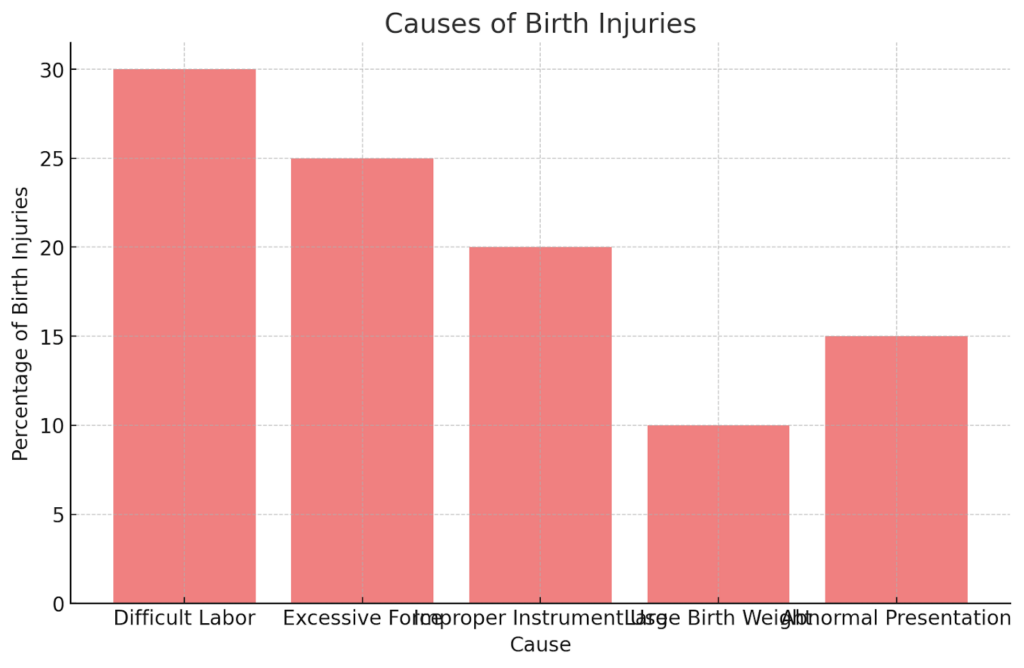
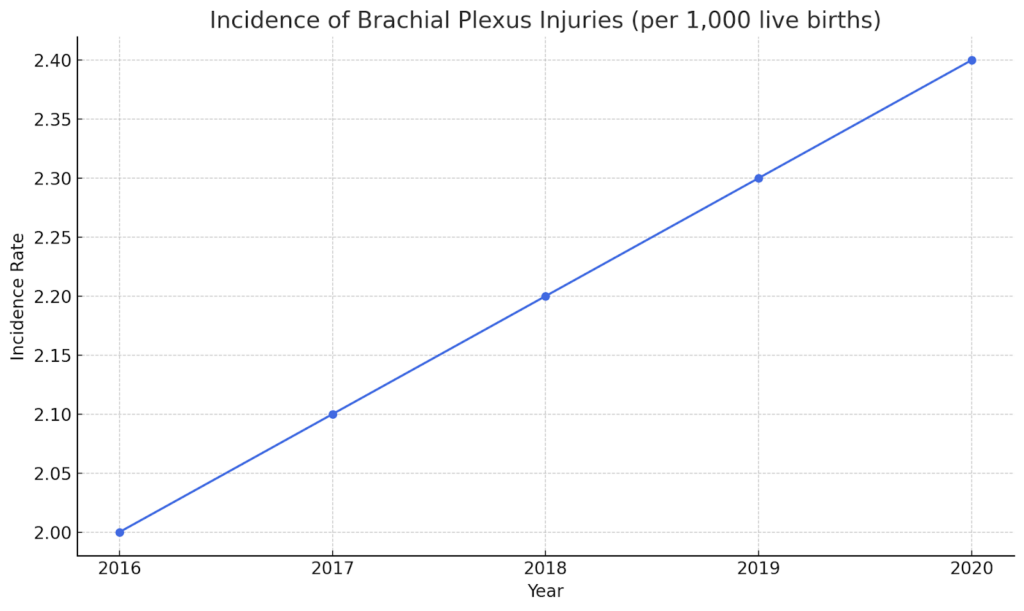
Birth Injury Lawsuit FAQs
If your child suffered an injury caused by medical negligence during pregnancy, labor, or delivery, our Essex birth injury lawyer can evaluate your case to determine what legal recourse you may have. Call Parker, Pallet, Slezak & Russell, LLC to learn more about our success stories, past cases, and how we can help you.
What Types Of Damages Are Available In A Birth Injury Lawsuit?
In a birth injury lawsuit, the damages that can be sought typically fall into two main categories: economic and non-economic damages. These aim to compensate the injured party (usually the child and their family) for the harm caused by medical malpractice or negligence during childbirth.
Economic damages are tangible and measurable financial losses. They include:
- Medical Expenses: The cost of treating the immediate and ongoing birth injury can be significant. This includes hospital bills, surgeries, physical therapy, medications, and any special medical equipment the child might need, such as wheelchairs or speech therapy aids.
- Future Medical Costs: In severe cases where the child requires long-term care, economic damages include estimates of future medical expenses incurred over the child’s lifetime.
- Lost Income: If a parent must reduce working hours or quit their job to care for the injured child, they can seek compensation for lost wages. This also includes the potential loss of future earning capacity due to the injury.
Non-economic damages are more complex to quantify but are just as important. Your personal injury lawyer will use certain formulas to make these calculations. These damages include:
- Pain And Suffering: This accounts for the physical and emotional pain the child experiences due to the injury. It can also include the pain experienced by the parents and family members as they watch their child suffer.
- Emotional Distress: The psychological trauma caused by witnessing a birth injury can be significant. This includes the anguish and stress experienced by the parents and caregivers.
How Are Future Medical Costs Calculated In A Birth Injury Lawsuit?
In birth injury lawsuits, calculating future medical costs is critical to determining compensation. Since birth injuries can result in lifelong needs, accurately projecting these costs can significantly impact the total damages awarded.
- Medical Expert Testimony: To calculate future medical expenses, a birth injury lawyer often relies on expert testimony from medical professionals who can estimate the ongoing care the child will require. These experts evaluate the nature and severity of the injury, determine the potential long-term care needed, and make projections based on current medical costs.
- Life Care Plans: A life care plan is a detailed document created by healthcare professionals that outlines the expected medical care and therapies the child will need throughout their life.
Can A Family Be Compensated For Emotional Distress In A Birth Injury Lawsuit?
Yes, emotional distress is a recognized form of damage in birth injury lawsuits. The emotional toll on the family, especially parents, can be severe, and compensation is often awarded to acknowledge this suffering.
- Parental Emotional Distress: In cases where the birth injury is caused by medical negligence, parents may experience significant psychological trauma, including anxiety, depression, or PTSD. The emotional pain of dealing with a child’s birth injury—especially if it results in long-term or permanent disabilities—can be devastating. Courts may award compensation for the emotional and psychological effects this causes.
- Family Member Distress: While the parents make most claims, other family members (such as siblings) profoundly affected by the child’s injury may also be entitled to compensation for emotional distress. However, this depends on the specifics of the case and local laws.
- Impact On Family Dynamics: A birth injury can alter the family’s daily life and future plans. Parents may need to devote more time to care for the injured child, which can create stress in other relationships and disrupt the family’s overall well-being. Compensation for emotional distress is designed to address the long-term effects of these changes.
Are Punitive Damages Available In A Birth Injury Lawsuit?
In some cases, punitive damages may be awarded in a birth injury lawsuit, although they are less common than economic and non-economic damages. Punitive damages are intended to punish the defendant (often a medical professional or hospital) for particularly egregious.

Essex Birth Injury Glossary
At Parker, Pallett, Slezak & Russell, LLC, we know that birth injuries can change lives in an instant. For nearly 50 years, we’ve been dedicated to helping families in Essex, Maryland, secure justice and fair compensation. Below, we’ve compiled essential terms to help you understand the key legal concepts that may arise when working with our birth injury lawyer.
Medical Malpractice In Childbirth
Medical malpractice refers to a healthcare provider’s failure to deliver the standard of care during childbirth, resulting in harm to the mother or baby.
For example, improper use of forceps during delivery could cause serious injuries like brachial plexus damage or fractures. In a legal context, proving malpractice involves showing that the healthcare provider’s actions deviated from accepted medical practices and directly caused the injury. Families who experience this often face significant emotional and financial challenges. We help clients uncover the evidence necessary to seek justice for these preventable errors.
Brachial Plexus Injury
A brachial plexus injury occurs when the network of nerves controlling movement in the shoulder, arm, and hand is stretched, compressed, or torn during childbirth. This can happen during complications like shoulder dystocia, where the baby’s shoulder becomes lodged in the birth canal.
Symptoms may include weakness, paralysis, or lack of sensation in the affected arm. Treatment often involves physical therapy, and in severe cases, nerve graft surgery may be necessary. Legal cases for this injury focus on whether the medical team failed to respond appropriately to delivery challenges, leading to avoidable nerve damage.
Cephalohematoma
Cephalohematoma is the pooling of blood between a baby’s skull and the periosteum, typically caused by pressure during delivery. This condition frequently arises from the use of delivery tools like forceps or vacuum extractors.
While it usually resolves on its own within weeks, complications such as jaundice or anemia can arise. In these cases, medical intervention may be required, and families may face unexpected medical expenses. Legal claims for cephalohematoma injuries often examine whether improper tool usage or inadequate monitoring during delivery played a role in the condition’s development.
Shoulder Dystocia
Shoulder dystocia is a childbirth complication in which a baby’s shoulders become stuck behind the mother’s pelvic bone during delivery. It’s an emergency situation that can result in injuries such as fractures or brachial plexus damage if not managed correctly. Medical teams are trained to use specific maneuvers and tools to safely deliver the baby.
Failure to respond effectively can lead to long-term consequences for the child, including limited mobility or chronic pain. Families who encounter this complication may have grounds for a legal case if the medical team’s actions caused or worsened the injuries.
Failure To Monitor Fetal Distress
Fetal distress refers to signs that a baby is not receiving enough oxygen during labor or delivery, such as abnormal heart rates detected through monitoring devices. When medical professionals fail to act promptly on these warning signs, serious conditions like cerebral palsy or brain damage can result.
For example, delaying a necessary emergency C-section might lead to permanent harm. Legal cases involving fetal distress often focus on whether the medical team failed to take timely action to prevent avoidable injuries, leaving families to cope with life-altering consequences.
Call Our Injury Law Firm Today
If your family is dealing with the aftermath of medical negligence that caused birth injuries, call Parker, Pallet, Slezak & Russell, LLC to schedule a free consultation with our firm. We will fight to get your family the financial justice you deserve.

Contact Us Now for a Free Consultation
Fill out the form below and we will respond to you as soon as possible
Contact Us Now Form
Other Practice Areas
Client Review
"I had an amazing experience with Parker, Pallett, Slezak and Russell. My lawyer was Carmen Slezak she was amazing her and her team worked with me every step of the way. Amazing staff always an amazing atmosphere, friendly, and if you like dogs they have one or two at the office. I'm so thankful and greatful to have met the staff and feel almost like family. Thank you again Parker, Pallett, Slezak & Russell law office."
G Amato

Parker, Pallett, Slezak & Russell, LLC
11450 Pulaski Hwy
White Marsh, MD 21162
Toll free: (410) 335-3800







